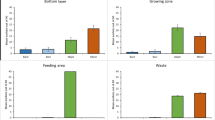Summary
More than 90% of media workers with head widths 1.8–2.2 mm, comprising the largest and energetically most efficient segment of the foraging force, were removed from four Atta cephalotes colonies containing approximately 8,000 workers. Contrary to expectation, the colonies did not respond by adding workers from adjacent size classes (head width ≦1.6 mm, ≧2.4 mm) to the foraging force (Table 1, Fig. 1). Yet the rate of leaf harvesting remained unaffected, due to the fact that excess workers in the adjacent size classes were already present on a stand-by basis in the foraging area (Table 2, Fig. 2). Moreover, the few survivors in the 1.8–2.2 mm group increased their individual activity by approximately 5x. In control and undisturbed colonies, the prime foragers in the 1.8–2.2 mm group tended to displace the others from the edges of the leaves, where most cutting takes place. When these individuals were removed, the auxiliaries participated more actively.
Brood development was followed through 2 full development cycles after the excision. No differential increase of the extirpated worker class (1.8–2.2 mm) could be detected in the experimental colonies when compared with sham-treated control colonies. As a consequence, this group remained underrepresented in the foraging arenas by about 50% at the end of the first cycle (8 weeks), but was fully replenished by the end of the second cycle (16 weeks).
The size-frequency distributions of the worker pupae belonged to one or the other of three patterns among both experimental and control colonies: unimodal at head width 0.8 mm, unimodal within 1.4–2.0 mm, or bimodal at these two respective positions (Fig. 3). Several colonies shifted from one pattern to another during a single brood cycle (Table 3). A hypothesis of the control of the size-frequency distribution has been developed consistent with these results.
Similar content being viewed by others
References
Autuori M (1956) La fondation des sociétés chez les fourmis champignonnistes du genre Atta (Hym. Formicidae). In: Autuori M et al. (eds) L'instinct dans le comportement des animaux et de l'homme. Masson, Paris, pp 77–104
Barrer PM, Cherrett JM (1972) Some factors affecting the site and pattern of leaf-cutting activity in the ant Atta cephalotes L. J Entomol 47:15–27
Eibl-Eibesfeldt I (1967) Atta cephalotes (Formicidae): Schneiden und Eintragen von Blattstücken; Parasiten-Abwehr. Encycl Cinematogr (Inst Wiss Film, Göttingen, no E1407)
Eidmann H (1935) Zur Kenntnis der Blattschneiderameise Atta sexdens L., insbesondere ihrer Ökologie. Z Angew Entomol 22:185–241, 385–436
Gregg RE (1942) The origin of castes in ants with special reference to Pheidole morrisi Forel. Ecology 23:295–308
Nijhout HF, Wheeler DE (1982) Juvenile hormone and the physiological basis of insect polymorphisms. Q Rev Biol 57:109–133
Oster GF, Wilson EO (1978) Caste and ecology in the social insects. Princeton University Press, Princeton, NJ
Passera L (1974) Différenciation des soldats chez la fourmi Pheidole pallidula Nyl. (Formicidae Myrmicinae). Insectes Soc 21:71–86
Passera L (1977) Production des soldats dans les sociétés sortant d'hibernation chez la fourmi Pheidole pallidula (Nyl.) (Formicidae, Myrmicinae). Insectes Soc 24:131–146
Shepherd JD (1982) Trunk trails and the searching strategy of a leaf-cutter ant, Atta colombica. Behav Ecol Sociobiol 11:77–84
Sokal RR, Rohlf FJ (1969) Biometry. Freeman, San Francisco
Wheeler DE, Nijhout HF (1981) Soldier determination in ants: New role for juvenile hormone. Science 213:361–363
Wilson EO (1980a) Caste and division of labor in leaf-cutter ants (Hymenoptera: Formicidae: Atta). I. The overall pattern in A. sexdens. Behav Ecol Sociobiol 7:143–156
Wilson EO (1980b) Caste and division of labor in leaf-cutter ants (Hymenoptera: Formicidae: Atta). II. The ergonomic optimization of leaf cutting. Behav Ecol Sociobiol 7:157–165
Wilson EO (1983) Caste and division of labor in leaf-cutter ants (Hymenoptera: Formicidae: Atta). IV. Colony ontogeny in A. cephalotes. Behav Ecol Sociobiol 14:55–60
Author information
Authors and Affiliations
Rights and permissions
About this article
Cite this article
Wilson, E.O. Caste and division of labor in leaf-cutter ants (Hymenoptera: Formicidae: Atta). Behav Ecol Sociobiol 14, 47–54 (1983). https://doi.org/10.1007/BF00366655
Received:
Accepted:
Issue Date:
DOI: https://doi.org/10.1007/BF00366655




